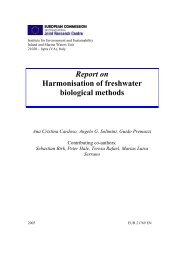Lakes and Watercourses
Lakes and Watercourses
Lakes and Watercourses
You also want an ePaper? Increase the reach of your titles
YUMPU automatically turns print PDFs into web optimized ePapers that Google loves.
TP ref (kg P/ha, year) =<br />
0.002 · x 1 + 0.015 (1)<br />
(0.10 · x 2 + 1.2) / (5 · x 2 + 12) (2)<br />
0.91 · x 3 · 10 –3 + 0.02 (3)<br />
2.45 · x 4 · 10 –3 + 0.024 (4)<br />
3.15 · x 1 · 10 –4 · (5 + 60 · x 5 ) (5)<br />
TN ref (kg N/ha, year) =<br />
0.018 · x 1 + 0.85 (6)<br />
–0.023 · x 2 + 1.25 (7)<br />
0.008 · x 3 + 0.85 (8)<br />
0.03 · x 4 + 0. 90 (9)<br />
3.15 · x 1 · 10 –4 · (125 + 500 · x 5 ) (10)<br />
where x 1 = specific flow (l/km 2 , sec)<br />
x 2 = lake percentage in catchment<br />
x 3 = area-specific loss COD Mn (kg/ha, year)<br />
x 4 = area-specific loss silicon (kg/ha, year)<br />
x 5 = flow-weighted mean absorbency 420 nm (abs f 420/5 )<br />
The new function (5, 10) uses the absorbency of the water measured<br />
using filtered water (0.45 µm membrane filter) in a 5 cm cuvette at a<br />
wavelength of 420 nm. Taking account of the element of uncertainty<br />
introduced, absorbency (abs f 420/5 ) can be calculated by multiplying<br />
water colour (mg Pt/l) by 0.002.<br />
COD Mn is derived by dividing the permanganate number by 3.95.<br />
One of these equations may be unsuitable for use in some situations.<br />
Hence, organic matter may raise the concentration of oxygen-consuming<br />
substances, which will render use of COD inappropriate. If the pollutant<br />
is largely uncoloured matter, the absorbency function (5, 10) will be a<br />
better guide. This should in turn be avoided where it is suspected that<br />
water colour is anthropogenically elevated, eg, as a result of discharges<br />
from pulp <strong>and</strong> paper mills, leachate from rubbish tips or because of<br />
increased humus losses caused by forestry practices. Silica (4, 9) may also<br />
be anthropogenically affected, eg, in the form of lower concentrations<br />
due to eutrophication, which will particularly impact on water systems<br />
containing many lakes.<br />
27















![Accommodation booking form [PDF]](https://img.yumpu.com/39471785/1/184x260/accommodation-booking-form-pdf.jpg?quality=85)

